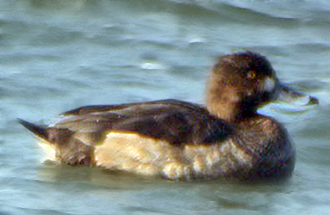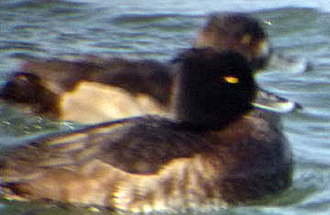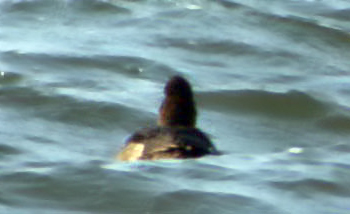
The Nakdong estuary can be considered one of the best places to look for Nearctic species on the Korean peninsula - with historical claims of Barrow’s Goldeneye Bucephala islandica and in more recent years, Wilson’s Phalarope Phalaropus tricolor, and fully-documented Savannah Ammodramus sandwichensis and White-crowned Sparrows Zonotrichia leucophrys.
Birding the estuary, on the seaward side of the barrage on January 13th 2004 with Tim Edelsten, Nial Moores found at between ca 40 and 100 m range a puzzling female-type aythya, which seemed to show several features suggesting yet another American species: Lesser Scaup Aythya affinis, a species recorded in neighboring Japan, but as yet unrecorded in South Korea.
Similar in size to or even slightly smaller than several of the Tufted Duck Aythya fuligula it was with, it looked fairly obviously "scaup-faced", with rather extensive white around the bill base, and most notably a faint pale patch towards the lower rear ear coverts (more obvious at some angles than others). In addition it had an obviously larger and heavier bill, recalling Greater Scaup Aythya marila - though with rather extensive black near the tip, extending off the nail, and a broad bluish subterminal band - both features somewhat recalling Common Pochard Aythya ferina. The iris was yellow-brown. The head looked rounded at some angles, rather flatter at others, and the best image taken makes the bird look rather flatter-headed than it actually appeared in the field - perhaps partly due to our being on a raised bank looking down on it. In addition, it lacked any hint of tuft - as did at least two of the 20 or so other Tufted Duck present near it (even into February). The flanks were obviously paler than the mantle (which in turn was mid- or dark brown, only very faintly washed with grey, and completely lacking any clear grey tones), making the bird appear more cleanly contrasting than either "typical" female-type Greater or Lesser Scaup, and paler overall than especially the latter. The undertail also showed extensive off-white - although shown by some female-type scaups this seemed perhaps more suggestive and typical of Tufted Duck. Considering that the bird seemed to show mixed characteristics of both Lesser Scaup and Tufted Duck or perhaps Greater Scaup, a few digi-scope images were hastily taken before it drifted too far away from us.


Returning on January 27th and again on February 11th, Nial Moores easily re-found the same individual in the same stretch of river, though no more images could be taken due to strong winds and glare. By the 11th, the white band above the bill base appeared perhaps rather more suffused with buff, and the pale "face" patch at some angles showed even more obviously; the flanks looked rather more mottled; and the previously whitish undertail appeared more variegated in appearance. The size of the bird was again noted as being very slightly smaller than several of the accompanying Tufted Duck, and for the first time too, the bird was also seen in flight, clearly, at close range, and in total for ca 10 seconds in direct comparison with 3 Tufties. Adding greatly to the interest, the upperwing in this fly-by looked "all Lesser Scaup" - with a bright white band across the secondaries, contrasting clearly with more dusky-washed inner primaries…The underwing was not well seen.

All considered, this individual is surely (and sadly!) most likely a hybrid - in consideration of its small size and upperwing pattern, combined with its large bill, flattish head, weak "scaup-face" and otherwise Tufted Duck-like plumage - probably between Lesser Scaup and either Greater Scaup or Tufted Duck.
Lacking information on the appearance or occurrence of such hybrids (would it be the first such noted in Asia?) or even on the possible variation within female-type Lesser Scaup, we would very much welcome, (as always) comments on this note and the accompanying images from experienced observers.
Birds Korea 1108 Ho, 3 Dong, Samick Tower Apt., 148-22, Namcheon-Dong, Su-Young-Gu
Busan, 618-762 Republic of Korea



